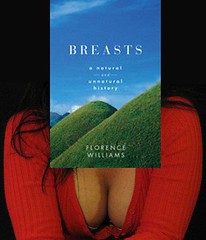 Everybody loves them, but few men (or women) take them seriously. Human breasts are admired and abused, shaped and enhanced, and — in the modern age — often never used for their evolved purpose.
Everybody loves them, but few men (or women) take them seriously. Human breasts are admired and abused, shaped and enhanced, and — in the modern age — often never used for their evolved purpose.
The story and science of breasts are fascinating subjects, so it’s no wonder that Florence Williams addressed the jokes and the oogling factor in the very first chapter of Breasts: A Natural and Unnatural History [LibraryThing / WorldCat]. It allowed her to get the juvenile chuckling out of the way and move into the more serious topics that the inevitable tongue-wagging tends to obscure. I imagine you’d have to be armed with wit if you want to be taken seriously on subjects like boobies, scrota, farts, etc., so the strategy is a good one: acknowledge the joke elephants in the room and get on with it.
Williams writes admirably with seriousness and light humor in a style similar to that of Mary Roach, talented author of Stiff and Bonk. And she works through her narrative’s many subjects with ease. She offers historical background, conversations with scientists and non-scientists alike, and adds her personal experiences. The science is still a relatively new field considering breasts and lactation have been critical to humanity and even gave our order — mammals — its defining name. Extensive research just hasn’t happened to the degree of other body parts. “It’s because the field is dominated by men who don’t think much of breasts except as sexual objects,” one male researcher told her.
Williams explores organ development (the only human organ built completely after birth!), the often brutal history of enhancements, the world of implants at a busy Houston clinic, and the packaging for public display. She discusses the morphing breast during a monthly period, during pregnancy, while nursing, and over a lifetime. They never stop changing. She describes the science of lactation (fuckling, in Olde English script where the letter s looks like an f) and the breast’s ability to adjust milk production for the nutritional and immunity needs of the infant. That topic alone was intriguing for this frequent reader of non-fiction and popular science. There’s a remarkable interaction between mother and infant that the breasts mediate. It’s not a one-sided conversation and it’s not as straightforward as you might expect. For instance, milk made for a male child is more energy dense than for a female and the speculation is just as surprising. The immunity agents that flood human breast milk is tailor-made, as well, permitting the infant to get what he/she needs with changing health or environmental factors. No artificial baby formula has matched it.
There are also problems. The hyper-interactive human breast seems adept at absorbing toxins and other chemicals. Pollutants accumulate in breasts more than other parts of the body. This can be a life-long danger to the breast-feeding infant as well as the woman. Breast cancer rates have increased world-wide in recent decades and scientists seeking answers have found correlations among the dozens of suspects — including: much earlier start of puberty (why is that happening?), late-in-life motherhood, a lifetime without childbirth, environmental and (sadly) often unconsidered household toxins. One surprising avenue of research is breast cancer among men. Geographic hotspots among a much smaller research sample size could make finding disease-causing culprits a little easier to study.
This is not a breast-feeding tome or a let’s-be-happy-with-our-bodies book for women-only. It’s well-written non-fiction about a subject that women AND men have an interest in seeing healthy and babies often depend upon. Don’t be distracted by their beauty; learn what’s going on inside.
PHOTO © Steve Campion

